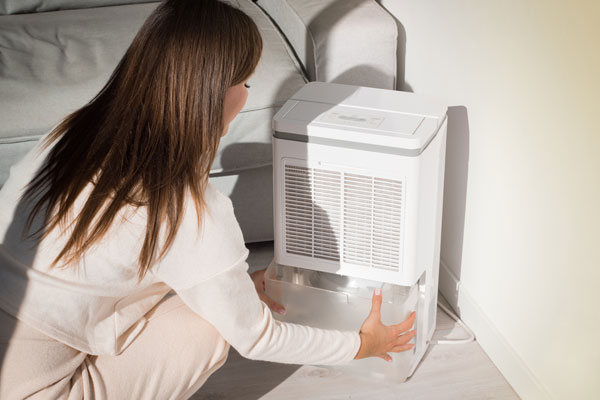A dehumidifier is an essential household appliance designed to remove excess moisture from the air, improving indoor air quality and protecting your home and health. Whether you’re dealing with a damp basement, humid bathroom, or allergy triggers, a dehumidifier can help maintain a healthy environment.
What Is a Dehumidifier and How Does It Work?
A dehumidifier works by pulling moist air into the unit using a fan. The air then passes over cool coils, causing the moisture to condense into water droplets, which are collected in a reservoir or drained via a hose. The dry air is then reheated and expelled back into the room.
There are two primary types of dehumidifiers based on the method of moisture extraction:
- Refrigerant (Compressor-Based): Ideal for warm, humid conditions.
- Desiccant (Absorption-Based): Effective in cooler environments.
Key Benefits of Using a Dehumidifier
1. Reduces Humidity Levels
High humidity levels can make a room feel uncomfortably warm and sticky. A dehumidifier helps maintain the ideal indoor humidity range of 30% to 50%, promoting comfort and energy efficiency.
2. Prevents Mold and Mildew Growth
Excess moisture creates a breeding ground for mold, mildew, and dust mites, all of which can trigger allergies and respiratory issues. Dehumidifiers actively prevent these health hazards by maintaining dry conditions.
3. Improves Indoor Air Quality
By controlling moisture, dehumidifiers limit the proliferation of allergens, musty odors, and pollutants. This results in cleaner, fresher air, especially beneficial for asthma and allergy sufferers.
4. Protects Your Home and Belongings
Humidity can warp wood, peel paint, rust metal, and damage books or electronics. A dehumidifier helps protect furniture, walls, floors, and valuables from moisture damage.
5. Increases HVAC Efficiency
When indoor air is too humid, your air conditioner must work harder to cool the space. Dehumidifiers lighten the load, reducing energy consumption and wear on your HVAC system.
Types of Dehumidifiers: Which One Is Right for You?
1. Refrigerant Dehumidifiers
- Best for: Warm and humid areas
- How it works: Uses cooling coils to condense moisture
- Pros: High capacity, energy-efficient in warm climates
- Cons: Less effective in cooler temperatures
2. Desiccant Dehumidifiers
- Best for: Cold or unheated spaces (e.g., garages, basements)
- How it works: Absorbs moisture using a drying agent (desiccant)
- Pros: Quiet operation, works in low temperatures
- Cons: Generally lower capacity and higher cost
3. Whole-House Dehumidifiers
- Best for: Large homes or those with central HVAC systems
- How it works: Installed in HVAC ductwork to dehumidify the entire home
- Pros: Seamless, high-capacity, automatic control
- Cons: Higher initial cost, requires professional installation
4. Portable Dehumidifiers
- Best for: Single rooms or small apartments
- How it works: Standalone units, often with wheels for mobility
- Pros: Affordable, easy to use, available in various capacities
- Cons: Needs regular emptying or drainage setup
Choosing the Right Size Dehumidifier
The effectiveness of a dehumidifier depends on choosing the correct capacity, typically measured in pints per day (PPD). Factors to consider include room size and humidity level.
Capacity Guide:
- 30-pint: Small rooms or slightly damp spaces (500–1,000 sq. ft.)
- 50-pint: Medium rooms or very damp spaces (1,000–2,000 sq. ft.)
- 70-pint or more: Large rooms, basements, or wet spaces (2,000+ sq. ft.)
High-efficiency units certified by ENERGY STAR® are ideal for long-term usage with lower electricity bills.
Features to Look for in a Dehumidifier
1. Humidistat and Auto Control
An adjustable humidistat allows the dehumidifier to maintain a set humidity level automatically, turning on or off as needed.
2. Continuous Drain Option
Instead of manually emptying the reservoir, continuous drainage enables automatic water removal via a hose.
3. Auto Restart and Auto Defrost
In the event of a power outage, auto-restart restores settings. Auto-defrost prevents coil freezing, essential for low-temperature operation.
4. Filter Indicator and Washable Filters
A filter indicator notifies you when it’s time to clean or replace the air filter, enhancing air quality and device longevity.
5. Portability Features
Look for units with wheels and handles for easier movement between rooms.
Best Locations for Using a Dehumidifier
Basements
Typically high in humidity, basements benefit greatly from dehumidification to prevent musty odors and mold.
Bathrooms and Laundry Rooms
These spaces experience constant moisture. A compact unit can reduce condensation on windows, walls, and mirrors.
Kitchens
Steam from cooking raises humidity levels. A dehumidifier helps maintain air balance and protect cabinetry and appliances.
Bedrooms and Living Rooms
Use a quiet model to improve sleep quality and air comfort in commonly used living areas.
Maintenance Tips for Long-Term Efficiency
- Empty the reservoir regularly if not using a drain hose
- Clean or replace air filters every 2–4 weeks
- Check for dust buildup on coils and vents
- Inspect the power cord and plug for damage
- Store in a dry, cool place during off-season months
Regular maintenance ensures peak performance, prolongs lifespan, and reduces the risk of mechanical failure.

Dehumidifier vs Humidifier: Knowing the Difference
A dehumidifier reduces excess moisture, while a humidifier adds moisture to dry air. Choosing between the two depends on your indoor environment:
- Use a dehumidifier if:
- You notice mold or mildew
- Your home feels sticky or smells musty
- Allergies worsen in humid months
- Use a humidifier if:
- The air feels dry or causes static electricity
- Your skin, lips, or throat feel dry
- Wooden furniture starts to crack
Environmental and Health Considerations
Dehumidifiers not only protect your home’s structure but also contribute to a healthier living environment by:
- Reducing respiratory irritation
- Minimizing the spread of allergens
- Preventing mold-related illnesses
- Creating a comfortable climate for sensitive individuals
Conclusion: The Dehumidifier as a Smart Home Investment
Investing in a high-quality dehumidifier is a practical step toward improving comfort, health, and home preservation. With proper sizing, regular maintenance, and thoughtful placement, it becomes a vital tool in managing your indoor environment year-round.
Whether for health, efficiency, or protection, the value of a reliable dehumidifier cannot be overstated.


